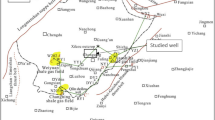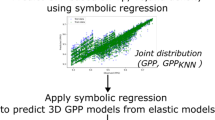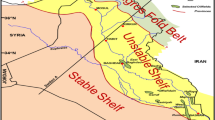Abstract
Pore pressure (PP) prediction from the downhole response is challenging due to the complex relationship between PP and the underlying variability of downhole response at continental slope setting. Conventional methods are mostly deterministic, and they do not usually take into account the underlying variability and uncertainty in the prediction. Here, we implement statistical machine learning (ML) augmented interpretation techniques for the prediction of PP of well 1344A located at the slope setting of sites IODP 323. Within this framework, we quantify the relative influence of each downhole response and hydrostatic pressure (HP) on PP prediction by taking, (i) downhole responses as input and PP as a target, and (ii) downhole responses + HP as input and PP as target and to fix input parameter lag by examining partial auto-correlation function (PACF) analysis results for ML model development. Comparative performance evaluation shows Gaussian process-based GPRN model is superior to the other three ML models such as ANFIS, ARD-BNN, and SVM based on R2 value between the target via Eaton’s and porosity methods and predicted via ML models. Uncertainty analysis shows that GPRN-based prediction falls within the 95% confidence interval (CI) at most of the depths. Further, the derivation of ML-based polynomial equations can be an interesting step towards the development of data-driven prediction of PP that potentially would be exploited for data-driven PP prediction studies in other complex geological settings of the world.

















Similar content being viewed by others
References
Ahmed A, Elkatatny S, Ali A, Mahmoud M and Abdulraheem A 2019a New model for pore pressure prediction while drilling using artificial neural networks; Arabian J. Sci. Eng. 44(6) 6079–6088.
Ahmed A, Elkatatny S, Ali A and Abdulraheem A 2019b Comparative analysis of artificial intelligence techniques for formation pressure prediction while drilling; Arabian J. Geosci. 12(18) 592.
Ashi J, Tokuyama H and Taira A 2002 Distribution of methane hydrate BSRs and its implication for the prism growth in the Nankai Trough; Marine Geol. 187(1–2) 177–191.
Bai J, Zhang X and Guo Y 2009 Different inertia weight PSO algorithm optimizing SVM kernel parameters applied in a speech recognition system; In: 2009 International Conference on Mechatronics and Automation, IEEE, pp. 4754–4759.
Benaouda D, Wadge G, Whitmarsh R B, Rothwell R G and MacLeod C 1999 Inferring the lithology of borehole rocks by applying neural network classifiers to downhole logs: An example from the Ocean Drilling Program; Geophys. J. Int. 136(2) 477–491.
Bishop C M 1995 Neural networks for pattern recognition; Oxford University Press.
Bowers G L 2001 Determining an appropriate pore-pressure estimation strategy. Paper presented at the Offshore Technology Conference, Houston, Texas, https://doi.org/10.4043/13042-MS.
Carcione J M, Gurevich B and Cavallini F 2000 A generalized Biot–Gassmann model for the acoustic properties of shaley sandstones; Geophys. Prospect. 48(3) 539–557.
Carcione J M, Helle H B, Pham N H and Toverud T 2003 Pore pressure estimation in reservoir rocks from seismic reflection data; Geophysics 68(5) 1569–1579, https://doi.org/10.1190/1.1620631.
Cranganu C 2007 Using artificial neural networks to predict the presence of over pressured zones in the Anadarko Basin, Oklahoma; Pure Appl. Geophys. 164(10) 2067–2081.
Daigle H, Worthington L L, Gulick S P and Van Avendonk H J 2017 Rapid sedimentation and overpressure in shallow sediments of the Bering Trough, offshore southern Alaska; J. Geophys. Res.: Solid Earth 122(4) 2457–2477, https://doi.org/10.1002/2016JB013759.
De Brabanter K, Karsmakers P, Ojeda F, Alzate C, De Brabanter J, Pelckmans K and Suykens J A K 2011 LS-SVM lab Toolbox User’s Guide, Version 1.8, Katholieke Universiteit Leuven, Department of Electrical Engineering, ESAT-SCD-SISTA, Kasteelpark Arenberg 10, B-3001 Leuven-Heverlee, Belgium.
Dugan B and Flemings P B 2000 Overpressure and fluid flow in the New Jersey continental slope: Implications for slope failure and cold seeps; Science 289(5477) 288–291.
Dürichen R, Pimentel M A, Clifton L, Schweikard A and Clifton D A 2014 Multitask Gaussian processes for multivariate physiological time-series analysis; IEEE Trans. Biomed. Eng. 62(1) 314–322.
Eaton B A 1975 The equation for geopressure prediction from downhole responses; In: Fall Meeting of the Society of Petroleum Engineers of AIME, Society of Petroleum Engineers.
Flemings P, Long H, Dugan B, Germaine J, John C M, Behrmann J H and Franke C 2008 Pore pressure penetrometers document high overpressure near the seafloor where multiple submarine landslides have occurred on the continental slope, offshore Louisiana, Gulf of Mexico.
Haris A, Sitorus R J and Riyanto A 2017 Pore pressure prediction using probabilistic neural network: Case study of South Sumatra Basin; In: IOP Conference Series: Earth Environ. Sci., IOP Publishing Ltd. 62(1) 1–6.
Hippert H S and Taylor J W 2010 An evaluation of Bayesian techniques for controlling model complexity and selecting inputs in a neural network for short-term load forecasting; Neural Netw. 23(3) 386–395.
Hu L, Deng J, Zhu H, Lin H, Chen Z, Deng F and Yan C 2013 A new pore pressure prediction method-back propagation artificial neural network; Electron. J. Geotech. Eng. 18 4093–4107.
Jang J S 1993 ANFIS: Adaptive-network-based fuzzy inference system; IEEE Trans. Syst., Man, Cybernet. 23(3) 665–685.
Karmakar M and Maiti S 2019 Short term memory efficient pore pressure prediction via Bayesian neural networks at Bering Sea slope of IODP expedition 323; Measurement 135 852–868.
Karmakar M, Maiti S, Singh A, Ojha M and Maity B S 2018 Mapping of rock types using a joint approach by combining the multivariate statistics, self-organizing map and Bayesian neural networks: An example from IODP 323 site; Marine Geophys. Res. 39(3) 407–419.
Keshavarzi R and Jahanbakhshi R 2013 Real-time prediction of pore pressure gradient through an artificial intelligence approach: A case study from one of middle east oil fields; European J. Environ. Civil Eng. 17(8) 675–686.
Li C, Zhan L and Lu H 2022 Mechanisms for overpressure development in marine sediments; J. Marine Sci. Eng. 10(4) 490.
Maiti S, Kumar C R, Sarkar P, Tiwari R K and Srinu U 2020 Interface depth modelling of gravity data and altitude variations: A Bayesian neural network approach; Neural Comput. Appl. 32 3183–3202, https://doi.org/10.1007/s00521-019-04276-9.
Mustafa M R, Rezaur R B, Rahardjo H and Isa M H 2012 Prediction of pore-water pressure using radial basis function neural network; Eng. Geol. 135 40–47.
Nabney I 2004 NETLAB: Algorithms for pattern recognition; Springer Science & Business Media.
Ohde A, Otsuka H, Kioka A and Ashi J 2018 Distribution and depth of bottom-simulating reflectors in the Nankai subduction margin; Earth, Planet. Space 70(1) 60.
Ojha M and Maiti S 2016 Sediment classification using neural networks: An example from the site-U1344A of IODP Expedition 323 in the Bering Sea; Deep Sea Res. Part II: Topic. Stud. Oceanogr. 125 202–213.
Osborne M J and Swarbrick R E 1997 Mechanisms for generating overpressure in sedimentary basins: A re-evaluation; AAPG Bull. 81(6) 1023–1041.
Rasmussen C E and Williams C K 2006 Gaussian processes for machine learning, MIT Press, Vol. 1, 39 40–43.
Schwartz F W and Longstaffe F J 1988 Groundwater and clastic diagenesis; In: Hydrogeology. The Geology of North America (eds) Back W, Rosenshein J S and Seaber P R, Geol. Soc. Am., Boulder Colorado O-2 413–444.
Singha D K and Chatterjee R 2014 Detection of overpressure zones and a statistical model for pore pressure estimation from downhole responses in the Krishna–Godavari Basin, India; Geochem. Geophys. Geosyst. 15(4) 1009–1020.
Takahashi K, Ravelo A C and Zarikian C A 2011 The expedition 323 scientists proceedings of the integrated ocean drilling program 323 1–105, https://doi.org/10.2204/iodp.proc.323.105.2011.
Tinivella U M and Berta 2002 The seismic response to over-pressure versus gas hydrate and free gas concentration; J. Seism. Explor. 11(3) 283–305.
Tinivella U and Guistiniani M 2011 Gas hydrate, free gas and overpressure; In: Proceedings of the 7th International Conference on Gas Hydrates (IGGH 2011), Edinburgh, Scotland, UK.
Tréhu A M, Bangs N L B and Guerin G 2006 Near-offset vertical seismic experiments during Leg 204; In: Proceedings of the Ocean Drilling Program. Scientific Results 204.
Vapnik V 2013 The nature of statistical learning theory; Springer Science & Business Media.
Walsh J B and Brace W F 1966 Cracks and pores in rocks; In: 1st ISRM Congress, International Society for Rock Mechanics and Rock Engineering.
Wang Z and Wang R 2015 Pore pressure prediction using geophysical methods in carbonate reservoirs: Current status, challenges and way ahead; J. Nat. Gas Sci. Eng. 27 986–993.
Xu W and Germanovich L N 2006 Excess pore pressure resulting from methane hydrate dissociation in marine sediments: A theoretical approach; J. Geophys. Res.: Solid Earth 111(B1).
Zhang J 2011 Pore pressure prediction from downhole responses: Methods, modifications, and new approaches; Earth-Sci. Rev. 108(1–2) 50–63.
Acknowledgements
We are grateful to Director, IIT (ISM), Dhanbad for permitting us to publish the work. MK is thankful to IIT (ISM) for funding PhD. SM is thankful to Science and Engineering Research Board (SERB) (Grant No: CRG/2018/001368) and TexMin (Grant No. PSF-1H-1Y-007), Govt. of India for funding AI/ML model development for prediction.
Author information
Authors and Affiliations
Contributions
MK performed all the experiments. SM designed the problem and supervised the work. Both authors contributed to writing the manuscript.
Corresponding author
Additional information
Communicated by Arkoprovo Biswas
Rights and permissions
About this article
Cite this article
Karmakar, M., Maiti, S. Statistical machine learning augmented interpretation of pore pressure of well 1344A located at slope setting of sites IODP 323. J Earth Syst Sci 132, 103 (2023). https://doi.org/10.1007/s12040-023-02114-0
Received:
Revised:
Accepted:
Published:
DOI: https://doi.org/10.1007/s12040-023-02114-0




